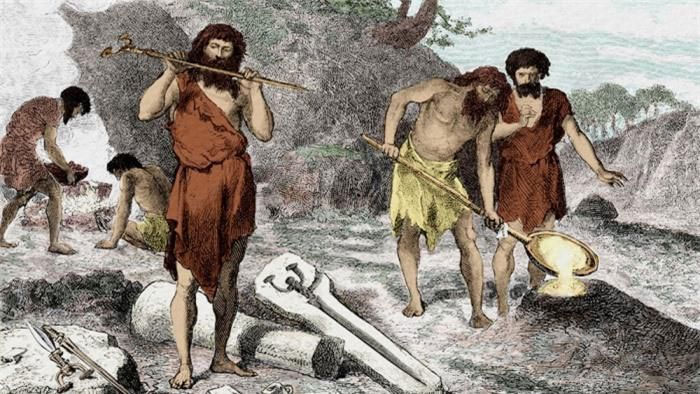The Bronze Age is one of the significant periods in the development of human history. During this time, humans began to discover methods of metallurgy and metalworking, contributing to a more civilized and advanced way of life.
The Bronze Age serves as a transitional period between the Stone Age and the Iron Age. It lasted from approximately the middle of the 5th millennium BC to the end of the 4th millennium BC or the beginning of the 3rd millennium BC. This phase extended over thousands of years, as it took a long time for humans to master the processes of smelting ores and casting metals.
The Bronze Age did not begin simultaneously across the globe. In many regions, it was a process of isolated development. As stone tools reached their highest stage of development, the emergence of a new material brought about significant changes in human social life.
During this period, many new cultures emerged. The economy developed increasingly, leading to the establishment of long-distance trade routes. The “Warrior Culture” gained more emphasis, especially in Europe. In the field of archaeology, the first signs of massacres, battles, and burial sites for warriors began to appear alongside the rise of the Bronze Age.

Ancient people melting copper ore to cast tools and weapons. (Image: Wikimedia).
Copper is a malleable metal, but it is much harder and more flexible than stone. Ancient people commonly used copper to make weapons and tools. They also discovered that by adding tin to copper, the resulting metal product became harder and more durable than before.
Archaeologists have uncovered the earliest evidence of copper smelting in the Fertile Crescent – a crescent-shaped region in southeastern Turkey, known for the emergence of the famous Mesopotamian civilization. The earliest traces of metallurgy in general can also be found here, particularly at the Yarim Tepe site in present-day Iraq.
Despite the transition from stone tools to copper in the ancient Near East, stone tools did not entirely lose their utility. They remained essential tools for the impoverished population.
In South Asia, the use of copper is the most characteristic sign of the famous Indus Valley civilization. Researchers have discovered several copper artifacts at the archaeological site of Bhirrana, identified as the oldest location of the Indus Valley civilization. There, they found copper arrowheads and bracelets.
Further west, in present-day Pakistan, archaeologists uncovered notable artifacts, including 12 copper swords dating from 3000 BC to 2500 BC. These swords are very thin and were likely used as tools for producing pottery – a crucial item in the Indus Valley during the Bronze Age. The local people traded pottery along extensive trade routes extending into northern Iran.
The Bronze Age played a crucial role in European history and the development of cultures that emerged during this period. Initially, Europe was primarily inhabited by ancient Europeans. Their indigenous culture existed long before the arrival of the Indo-European speakers.
For decades, scholars have agreed that the Bronze Age in Europe began around 3500 BC and lasted until 1700 BC. However, recent archaeological discoveries at a site in Serbia suggest that copper metallurgy in Europe occurred about 800 years earlier than previously understood. Specifically, researchers found a copper axe and metallurgical furnaces from the dominant Vinca civilization in the region. The use of copper quickly spread across Europe, contributing to the formation of many large settlements with surrounding walls. These settlements were primarily located near large copper ore deposits.
The most prominent cultures during the Bronze Age in Europe include the Villanovan culture, the Los Millares culture on the Iberian Peninsula, the Mondsee and Michelsberg cultures in Central Europe, and of course, the Vinca culture on the Balkan Peninsula.
One significant event that has provided us with new insights into human life during the Bronze Age in Europe is the archaeological discovery of Ötzi the Iceman. This mummy, dating back to 3300 BC, has been remarkably well-preserved in the icy conditions of the Alps. Beside the mummy was a copper axe made by the Mondsee culture, who had learned to mix copper with arsenic to create a material known as “Mondsee Copper.”
In the Americas, the use of copper and related changes in metallurgy occurred across various regions and timeframes. In Central America, metallurgy appeared relatively late, around 600 to 800 AD. In South America, civilizations in the Andes independently discovered how to smelt and cast copper tools. They traded goods with peoples in Central America through maritime trade routes. In North America, archaeologists have found substantial evidence of a place called the Old Copper Complex in the Great Lakes region of present-day Wisconsin and Michigan. Here, indigenous tribes extracted copper ore to create tools and weapons.
In many different ways, the advent of metallurgy during the Bronze Age was a factor that changed the course of human history. Copper and its applications led to significant transformations in the lives of the earliest civilizations in the world, ushering them into an increasingly advanced new era.
With all the social and economic changes during the Bronze Age, humans began transitioning to a settled lifestyle, moving away from the nomadic hunting and gathering of the Stone Age. Villages and fortified cities gradually became more common.
For ancient people, copper was a rare and difficult metal to refine. Therefore, initially, this metal emerged as a luxury item. Over time, the increasing demand for copper led to the development of mining, metallurgy, and refining activities. Trade networks gradually formed to facilitate the exchange of copper tools and goods.


















































